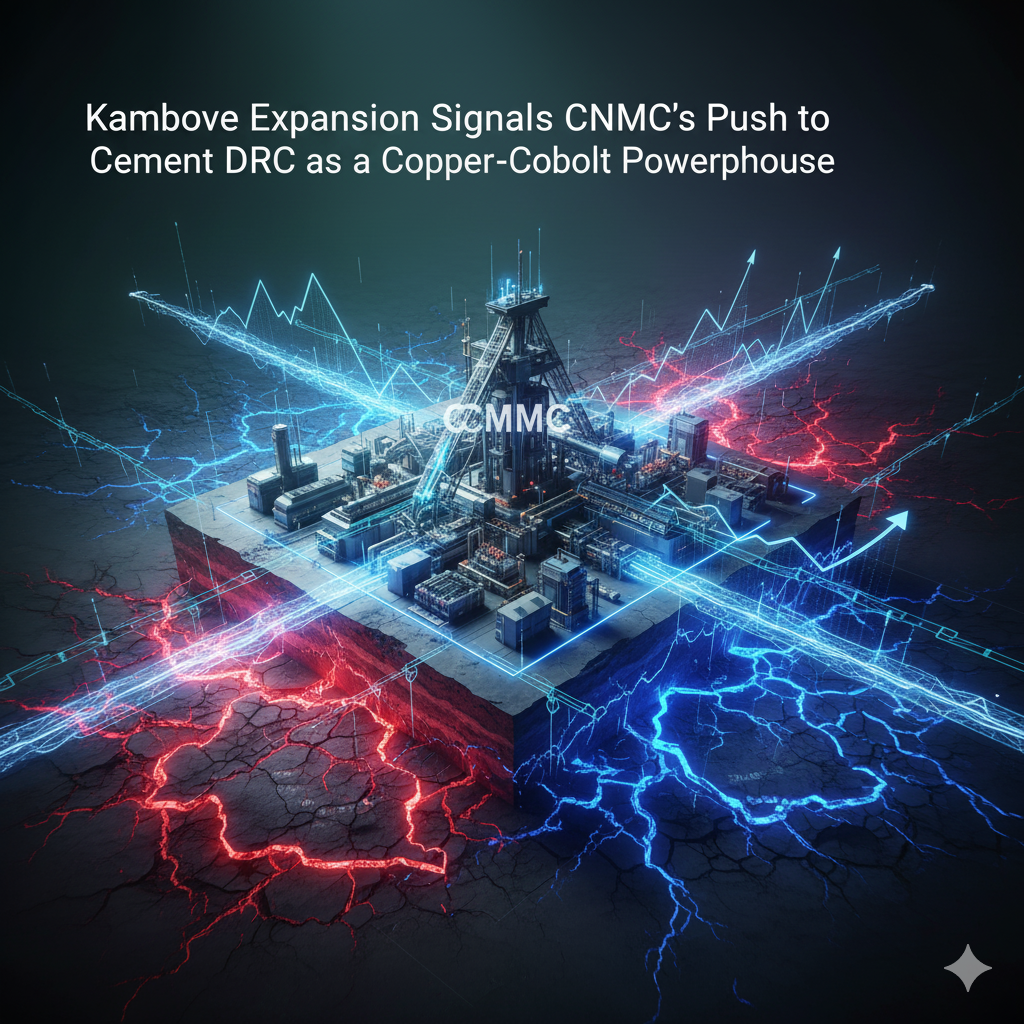Kambove Expansion Signals CNMC’s Push to Cement DRC as a Copper-Cobalt Powerhouse
CNMC’s US$85.8m expansion of DRC’s Kambove mine deepens China’s grip on copper and cobalt. By upgrading shafts, plants, and ESG systems, CNMC signals that mid-tier projects matter in the race to control minerals driving the energy transition.

China Nonferrous Metal Mining Corporation (CNMC) has begun a decisive new chapter at the Kambove mine in the Democratic Republic of Congo, moving forward with an ambitious expansion program designed to scale copper and cobalt output. With Phase I capital expenditure of about US$85.8 million earmarked for shaft sinking, water management, and processing plant upgrades, CNMC is signaling that Kambove will be more than a mid-tier producer. It is being positioned as part of Beijing’s larger strategy to cement the DRC’s role as a global copper-cobalt powerhouse.
Kambove already produced 34,439 tonnes of copper cathodes and 795 tonnes of cobalt hydroxide in 2024, modest numbers when set against the DRC’s mega-projects. Ivanhoe Mines’ Kamoa-Kakula (TSX: IVN) produced nearly 393,551 tonnes of copper last year, while China Molybdenum’s Tenke Fungurume (SHA: 603993) yielded 177,000 tonnes of copper and 16,000 tonnes of cobalt. Yet the scale of Kambove’s upgrade reveals CNMC’s strategy of building a diversified footprint across the Congolese copper belt rather than relying on just one or two headline mines. Each additional expansion strengthens China’s long-term resource control.
The engineering effort underscores that this is not merely about pulling out more ore. CNMC is sinking new shafts, dealing with water inflows of 42.56 m³/h, and reinforcing geological stability through aquifer grouting. On the processing side, upgrades include modernizing separation plants, expanding tailings systems, and installing a 10,000 Nm³/h oxygen generation system to improve recovery efficiency. These technical investments highlight CNMC’s desire to reduce operational risks while ensuring steady growth in output. The adoption of smart monitoring systems for tailings is also a sign that CNMC is responding to rising investor demands for ESG compliance, a factor that increasingly shapes financing access and cost of capital.
Financial arrangements add another layer to the story. In 2025, CNMC signed a US$67.03 million offtake deal with Gécamines, the state-owned miner that still holds a 45% stake in Kambove. The agreement secures steady sales for CNMC and reinforces Gécamines’ embedded role in the project. Yet, because it is technically a related-party transaction, it also raises governance questions. Such structures exemplify how Chinese SOEs integrate mining, marketing, and state relations to lock in strategic access, while leaving investors to weigh potential conflicts of interest against security of supply.
The DRC already supplies roughly 70% of global cobalt and about 10% of global copper, and Kambove’s expansion feeds into this dominance at a time when energy transition metals are in hot demand. Copper on the LME (LME: CMCU3) is trading around US$9,500/tonne, supported by grid expansion and EV manufacturing, while cobalt prices have oscillated between US$28,000 and US$40,000/tonne over the past year. By expanding its mid-tier portfolio, CNMC is betting that even as prices fluctuate, long-term demand will remain structurally strong.
Compared with Western operators, Chinese firms have proven more comfortable navigating the governance challenges of the DRC. This gives them an edge in consolidating supply chains critical to electrification. While Western mining giants such as First Quantum (TSX: FM) and Barrick Gold (NYSE: GOLD) have focused heavily on Zambia with multi-billion-dollar commitments, and juniors in Angola are attempting to replicate the DRC-Zambia model, China’s strategy has been to build dominance through multiple layered projects like Kambove. The sums may be smaller than Ivanhoe’s Kamoa, but collectively they deepen China’s grip on Africa’s copper-cobalt pipeline.
For investors, the immediate market impact of Kambove’s expansion is not about headline supply shocks. On its own, it cannot shift LME copper curves or cobalt benchmarks. Instead, its importance lies in what it signals. First, that Chinese SOEs remain willing to deploy capital into frontier jurisdictions despite governance risk. Second, that the DRC’s role as the mineral core of the energy transition is being reinforced, not diluted, by ongoing investment. Third, that ESG compliance and operational safety are now part of the Chinese mining narrative, not just Western rhetoric, as seen in CNMC’s tailings monitoring initiatives.
Global markets should care because every shaft sunk and every plant upgraded in Katanga locks more of the future supply of electrification metals into Chinese-controlled channels. This has direct implications for OEMs such as Tesla (NASDAQ: TSLA) and BYD (SHE: 002594, HKEX: 1211), which depend on secure and diversified battery metal supply. It also matters for investors in mining equities like Glencore (LSE: GLEN), whose exposure to cobalt is concentrated in the DRC, and for policy makers in Washington and Brussels seeking alternatives to Chinese-dominated supply chains.
Ultimately, we can assess that Kambove’s expansion is less about one mine and more about a structural shift. It demonstrates how China continues to stitch together a network of projects across Africa’s copper belt, ensuring that even mid-sized assets contribute to a long-term strategy of resource security. The DRC’s dominance in copper and cobalt is not being eroded—it is being deepened, with CNMC’s Kambove mine as one more piece in a mosaic that binds African minerals into the core of global energy transition supply chains.





